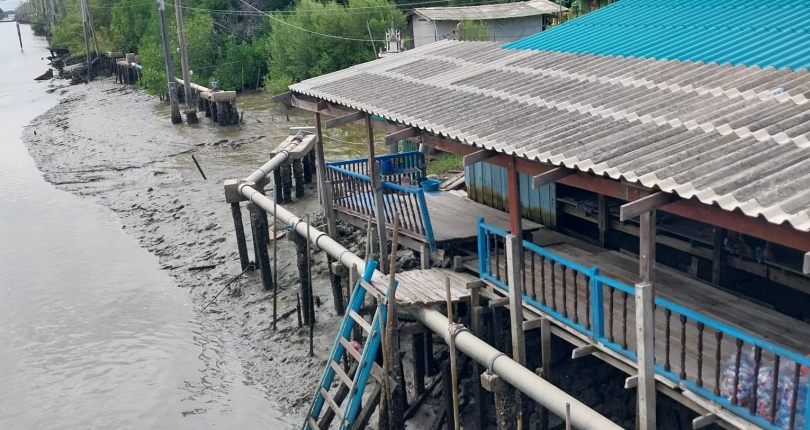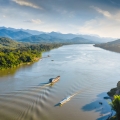How communities are adapting to the vanishing coastline of Bang Khun Thian in the Gulf of Thailand
As a once-thriving coastal way of life slowly disappears beneath rising sea levels, researchers are collaborating with vulnerable coastal communities to ensure they have a voice in shaping coastal retreat plans to adapt to climate change.
A historical landmark facing a crisis
We used to live there, but now it is all water. – A local resident in Samut Prakan
Wat Khun Samutrawat, a cultural and spiritual landmark near the Gulf of Thailand, has stood for generations as a symbol of community and tradition. But today, it faces an existential threat: rising sea levels. What was once a thriving area is now disappearing beneath the waves. Of the 100 communities that once called this place home, only 40 remain. The numbers continue to dwindle as the sea claims more land each year.

The temple itself, a centuries-old structure, remains standing—a testament to the community's resilience. Moving such a significant and ancient building is nearly impossible, so it continues to watch over the shrinking land around it. While it still serves as a unifying force for the community, it also stands as a poignant reminder of what has been lost.

Sea-level rise impacts the community
The remaining residents have adapted to their new reality. Most now live behind the temple, where homes have been raised to protect against the encroaching sea. While some run small grocery stores, many still rely on traditional livelihoods like shrimp farming and fishing. However, these occupations are becoming increasingly precarious. Local fishermen report declining fish populations, both in number and variety, as rising sea levels disrupt the marine ecosystem they depend on.

One of the most striking symbols of this crisis is the submerged high school. During low tide, parts of the building are still visible—a haunting reminder of the community’s past. This school was more than just a place of learning; it was a cornerstone of the community where generations of children grew up. Its submersion represents not only the loss of a building but also the erosion of a shared history.
Adapting to survive
In the face of rising seas, the community is fighting back with resilience and innovation. Residents are working together to raise homes, reinforce coastal defenses, and explore sustainable ways to farm and fish in their changing environment.

One promising solution is the restoration of mangroves, which act as natural barriers against erosion. In the Bang Khun Thian district, local mangrove conservation sites have been established. These areas not only protect against rising sea levels but also serve as educational and recreational spaces for locals and visitors alike.

Through these collective efforts, the community is not just trying to survive—they are finding ways to thrive alongside the sea. Their resilience and adaptability offer hope that, even in the face of environmental challenges, it is possible to preserve their way of life and the natural environment for future generations.
How the ReTrEAT Cities Project can HELP
The ReTrEAT Cities Project is working to empower vulnerable coastal communities like Bang Khun Thian to take part in coastal retreat plans for sea level rise. Unlike traditional top-down approaches, our project focuses on collaboration with local communities to create innovative, energy-neutral coastal retreat plans.
By involving those most affected in the planning process, we ensure that their voices and local knowledge shape the strategies. Our approach is inclusive, guided by the principles of Gender Equality, Disability, and Social Inclusion (GEDSI).
The ultimate goal is to better understand how sea level rise impacts these communities and their infrastructure, and to develop practical, equitable solutions. By addressing the interconnected challenges of water, energy, and climate, we aim to build resilient cities and communities in the Lower Mekong region that can adapt to these growing risks.
Hope amidst uncertainty
As Bang Khun Thian's coastline continues to vanish beneath rising tides, its people's resilience serves as a powerful reminder of human adaptability in the face of environmental challenges. The community’s efforts to safeguard their homes, livelihoods, and cultural heritage reflect not only a deep connection to the land but also an unwavering commitment to survival.
While the submerged high school and shrinking coastline symbolize loss, they inspire innovation and hope. The ReTrEAT Cities Project stands alongside these communities, ensuring their voices are heard in shaping sustainable retreat strategies. By fostering an inclusive, gender-sensitive approach, the project aims to create long-term, equitable solutions that empower coastal communities to thrive in a rapidly changing world.
This is not just about adapting to survive—it’s about embracing transformation to secure a future where both people and the environment can build resilience, united against the hazards of climate change.
Cover photo: A raised house, one of many adaptations to rising sea levels.
Photo 1: Map of the project site.
Photo 2a, b: Wat Khun Samutrawat, a cultural and spiritual landmark for the Bang Khun Thian community.
Photo 3: Light posts from the now-submerged high school in front of Wat Khun Samutrawat.
Photo 4: Local adaptation measures implemented to address rising sea levels.
Photo 5a, b: Mangroves Conservation Centre in the Bang Khun Thian district.
Photo Credits: Pyae Mon Naing / ReTrEAT Cities Project
Info
This story is part of the following project
Mekong Thought Leadership and Think Tanks Network
Topic
Country
Related people
You might be interested in
-
Grants open for research linking to policy action under Mekong Thought Leadership and Think Tanks Network Program
Mekong Thought Leadership and Think Tanks (MTT) Network Program calls for applications to its research-to-policy grants supporting evidence-based research that connects to practical solutions to challenges in the water-energy-climate nexus.
![Grants open for research linking to policy action under Mekong Thought Leadership and Think Tanks Network Program]()
-
Now open: fellowship opportunities under Mekong Thought Leadership and Think Tanks Program
MTT Program is opening a call for fellowships to be hosted in Cambodia, Lao PDR, Thailand, and Vietnam. The Program will award up to 13 high-quality entry- or mid-level professionals of all genders who are Mekong citizens.
![Now open: fellowship opportunities under Mekong Thought Leadership and Think Tanks Program]()
-
Call for 3rd batch applications: fellowship opportunities under Mekong Thought Leadership and Think Tanks Program
MTT Program is opening a call for fellowships to be hosted in Cambodia, Lao PDR, Thailand, and Vietnam. The Program will award up to 13 high-quality entry- or mid-level professionals of all genders who are Mekong citizens.
![Call for 3rd batch applications: fellowship opportunities under Mekong Thought Leadership and Think Tanks Program]()

 By
By




 Read more about SUMERNET
Read more about SUMERNET
